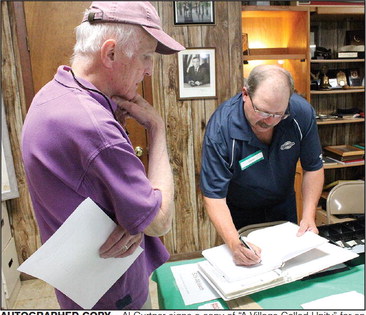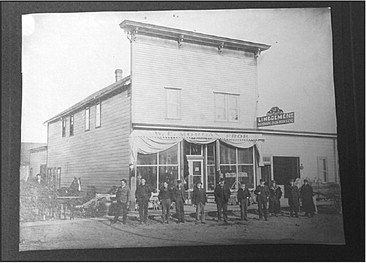‘A VILLAGE CALLED U


NITY’
Local man turns research into chronicle of community’s past
The American Legion Post in Unity hosted a reunion for alumni of the town’s schools two weeks ago, the location just big enough to hold the numerous guests. The schools that they attended no longer exist; there hasn’t been a high school in town since the 1960s and what was once the most recent elementary school has been converted into apartments. The people, however, remain connected by their alma mater, regardless how much time and distance has been put between them, or if the schools themselves still stand.
Al Gurtner mills around the event, talking to the other attendees. He enjoys chatting with them, but he’s also collecting their stories, their memories, their history. It’s something he’s been doing for the last several decades, a process that first started while he was working at his family’s store in Unity. People would stop by just to see how the place had changed in the years since they had left the community and he would talk to them about what they remembered.
What first started as a general interest in the family business’s history, piqued when someone gave him a postcard depicting what the place had looked like years prior, has grown exponentially since. After over two decades of interviewing, hunting down old photos, and painstakingly pecking out typed descriptions, Gurtner was finally able to collect much of his research into A Village Called Unity, his newly published book depicting the history of the town from the 1870s through the 1950s.
While the knowledge he has accumulated over the years eventually led him to writing the book, Gurtner did not foresee his work going in that direction when he first started to gather photos and conduct interviews in the early 2000s.
“I was just collecting it, not realizing how much stuff there was going to be,” Gurtner said. “I never had any intentions of writing a book at first; it was just ‘Wow, that’s really cool, I never knew that building used to be over there’ or what have you. It was a learning experience. I hadn’t realized that it was that old of a town and all of the things that used to be there.”
Which is largely what the book is about; a chronicle of how Unity has evolved over the years, from the old schools to the building where the St. Croix fishing rod company got its start. Most of these buildings are gone, with only the old bank and the building next to it still remaining. It is a story largely told through the pictures that Gurtner and his fellow Unity historian Dennis Kuehling have gathered and copied, taken largely from local families’ personal prints or old postcards featuring various village landmarks.
And while he may have not intended it to ever culminate in something like this book, once he realized how much information he had gained, Gurtner knew that he should do something with it. After speaking with his friend Kris Leonhardt, who works as an editor at Marshfield’s Hub City Times, a plan to create a book started to take shape.
“I called Kris over because she’s written a few books and is a big historian,” Gurtner said. “I told her that I have all of this stuff, but I just don’t know what to do with it. So she came out and took a look at what I had and we started to plan things out. She really gave me the shove that I needed to get going, because I didn’t know where to start.”
Once they had settled on writing a book, however, things started to fall into place. After a February meeting with Leonhardt, the work began in earnest, with a goal of getting the book out in time for the Unity reunion in September.
A huge part of the process was merely organizing the wealth of information that Gurtner and Kuehling had gained. That knowledge fills numerous tubs, boxes and binders, most of which now occupy an old bedroom turned workspace in the Gurtner home. He would disappear for hours each evening after work, sorting through postcards, skimming through notes and interviews, and typing up text descriptions, something that took several months. During this time he’d often consult with Kuehling, picking his brain for additional information. And while this work was certainly labor intensive, the number of hours put into this part of the process paled when compared to time Gurtner spent collecting everything that went into the book.
This is the part that Gurtner enjoyed the most. The interviews, the time spent sitting down with people and going through pictures, talking about their lives. He’d show people what he had found so far, his binders of pictures and postcards, scribbling down notes as they’d ignite conversations about certain aspects of Unity and its people that he had not known. He speaks fondly of chats that began in the evening and continued through to the early morning.
“I spent a lot of time with a lot of people,” Gurtner said. “At the time, it didn’t mean anything except to me. I was just doing it because I wanted to. But later on it helped bind this whole book together.”
Because not only does the book capture the physical locations of what was where and when, but it also has the stories of the people who lived and worked amongst those buildings infused into it. The interviews Gurtner has done carry with them the history of the people he has spoken to and one can find the essence of those discussions within its pages. As mentioned earlier, many of the pictures were taken from old postcards. Many of these postcards contained personal messages, and while these messages often had nothing to do with the image on the front, Gurtner still liked to include something about the letter and the individuals sending or receiving it in that picture’s description.
“These postcards are worth their weight in gold,” Gurtner said. “You sometimes learn more on the backside than the front. It helps piece together the full picture.”
By putting all of this information into the book, Gurtner hopes that he can share what he’s learned about the village of Unity, both its buildings and its people, with others. His biggest regret with this project is that some of the people he got to know during his chats with them did not get to see the finished product.
“A lot of people I’ve interviewed have passed away over the last twenty years since I started this [project],” Gurtner said. “I feel bad that the people couldn’t see the final product, but their families and anyone else from now on will be able to see and read what they told me about themselves and the town.”
Despite a tight deadline, Gurtner was able to get the work done in time to have the book readily available for those at the reunion, so they would have an opportunity to read through it while they enjoyed the company of their fellow Unity alumni. He also has been working with several area locations, like the Colby Community Library and the Marathon County Historical Society, to hold his book as well, so that it can reach other audiences who might have an interest in Unity’s history.
His book may be published, but Gurtner says that his work is far from over. During his time collecting stories about Unity, he also has come across a lot of information about the neighboring Romeo and Riplinger areas and Leonhardt has a good bit of research done on Atwood and Longwood. Between himself, Leonhardt and Kuehling, he hopes to continue to learn more about those and other small communities around the area and there are plans to write at least one more book.
The history of small, rural communities can be preserved in books like Gurtner’s and he hopes that he can continue to expand his knowledge and share what he learns with others. If the gathering of Unity alumni shows anything, it’s that regardless of whether schools, churches, or stores still stand, the bonds of the people who once inhabited those places remain. Even if the buildings are gone, they still affect us now, and will continue to do so into the future.

